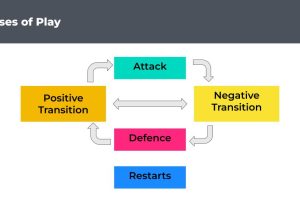Soccer Game Model Adaptability: Mastering Mid-Season Adjustments
Soccer coaches need to be able to adapt their game model mid-season to improve their team’s performance. A game model is a tactical/strategic approach that coaches develop to enhance their team’s functionality and performance on the field. It is a framework that coaches use to improve their team’s performance in specific sub-phases of play.
Understanding soccer game models is essential for coaches looking to make mid-season adjustments. Implementing adjustments requires a deep understanding of the game model and how it affects the team’s performance. The role of coaches and players is crucial in implementing these adjustments. Coaches need to be able to communicate effectively with their players and provide them with the necessary tools to succeed. Players, on the other hand, need to be open to new ideas and willing to put in the work to improve their performance.
Key Takeaways
- Adapting a soccer game model mid-season is crucial for improving team performance.
- Understanding the game model and its impact on performance is essential for making effective adjustments.
- Effective communication and a willingness to learn are crucial for coaches and players looking to implement mid-season adjustments.
Understanding Soccer Game Model
Defining the Game Model
A soccer game model is a tactical or strategic approach adopted by coaches to enhance player functionality and performance on the field. It is a framework developed by coaches to improve the team’s performance in specific sub-phases of play. The game model goes beyond formation or style. It includes how to build a play and finish it. The game model is the overarching, planned, tactical/strategic approach adopted, and tactical principles of play, conceived by coaches to enhance player functionality in specific sub-phases of play.
The game model is designed to help players understand their roles and responsibilities on the field. It provides a framework for players to work within and helps them to adapt to different playing styles. By adopting a game model, coaches can help their players to develop well-rounded soccer skills that allow them to adapt to other playing models.
Role of Tactical Principles
Tactical principles are the fundamental concepts that underpin the game model. They are the building blocks that coaches use to create a tactical framework for their team. Tactical principles include concepts such as pressing, counter-attacking, and possession-based play.
Coaches use tactical principles to create a game model that is tailored to their team’s strengths and weaknesses. By focusing on specific tactical principles, coaches can help their players to understand their roles and responsibilities within the team. This understanding allows players to make quick decisions on the field and adapt to changing game situations.
In summary, understanding the game model and its tactical principles is essential for soccer coaches. By adopting a game model, coaches can help their players to develop well-rounded soccer skills and adapt to different playing styles. Tactical principles provide the building blocks for the game model and allow coaches to create a tactical framework that is tailored to their team’s strengths and weaknesses.
Implementing Adjustments
Adjusting the soccer game model mid-season can be a challenging task. However, with proper planning, periodization, and training load management, coaches can successfully implement adjustments that can lead to improved performance on the field.
Planning and Periodization
Planning and periodization are crucial components of implementing adjustments mid-season. Coaches need to analyze the current state of their team and identify areas that need improvement. They can then develop a new game model that addresses these areas while also considering the team’s strengths and weaknesses.
To ensure that the adjustments are implemented effectively, coaches need to develop a periodization plan that includes macrocycles, mesocycles, and microcycles. The macrocycle is the entire season, while the mesocycle is a phase within the macrocycle, such as a month or a few weeks. The microcycle is a week or a few days.
Coaches need to plan each mesocycle and microcycle to ensure that the team is progressing towards their goals. They need to consider the training load, the type of training, and the intensity of the training. Coaches can use overload and tapering techniques to gradually increase the load and intensity of training while also allowing for recovery and rest.
Training Load Management
Training load management is another crucial component of implementing adjustments mid-season. Coaches need to ensure that their players are not overworked or underworked. Overworking players can lead to fatigue, injuries, and poor performance, while underworking players can lead to a lack of fitness and poor performance.
Coaches can use various methods to manage the training load, such as monitoring the players’ heart rate, using GPS tracking devices, and conducting regular fitness assessments. They can also adjust the training load based on the players’ individual needs and the team’s goals.
In conclusion, implementing adjustments mid-season requires proper planning, periodization, and training load management. Coaches need to analyze the current state of their team, develop a new game model, and plan each mesocycle and microcycle to ensure that the team is progressing towards their goals. They also need to manage the training load to prevent overworking or underworking players. By following these guidelines, coaches can successfully implement adjustments that can lead to improved performance on the field.
Role of Coaches and Players
Coaches’ Responsibilities
Coaches play a crucial role in adapting the soccer game model mid-season. They are responsible for identifying the areas that need improvement and making necessary changes to the game model. Coaches must analyze the team’s performance, identify the strengths and weaknesses of the players, and adjust the game model accordingly.
The head coach must lead the adaptation process and work with the coaching staff to ensure that the changes made to the game model are effective. Coaches should provide feedback to players on their performance and help them understand the changes made to the game model. It is important for coaches to communicate the changes to the players to ensure that they are aware of their roles and responsibilities on the field.
Jose Mourinho, a renowned soccer coach, emphasizes the importance of adapting the game model to suit the team’s needs. He believes that coaches must be flexible and willing to make changes to the game model to ensure that the team performs at its best.
Players’ Involvement
Players also play a critical role in adapting the game model mid-season. They must be willing to adapt to the changes made by the coaching staff and understand their roles and responsibilities on the field. Players should provide feedback to the coaching staff on their performance and suggest areas that need improvement.
It is essential for players to understand the changes made to the game model and how it affects their performance on the field. They should work closely with the coaching staff to ensure that they are implementing the changes effectively.
In summary, coaches and players must work together to adapt the game model mid-season. Coaches should lead the adaptation process and provide feedback to players, while players should be willing to adapt to the changes and provide feedback to the coaching staff. By working together, coaches and players can ensure that the team performs at its best and achieves its goals.
Performance Analysis and Feedback
Use of Statistics
Performance analysis is an integral component of understanding the requirements for optimal performance in soccer. Coaches and players use a variety of statistics to evaluate performance during a game. These statistics include pass completion rate, shots on goal, tackles, and more. By analyzing these statistics, coaches can identify areas of strength and weakness in their team’s performance.
In addition to identifying areas of strength and weakness, statistics can also be used to predict future performance. For example, a coach may notice that a particular player performs best when playing in a certain position on the field. By analyzing statistics from previous games, the coach can predict that the player will perform well in that position in future games.
Importance of Feedback
Feedback is an essential component of performance analysis. Without feedback, players and coaches would not be able to identify areas of weakness and make the necessary adjustments to improve performance. Feedback can come from a variety of sources, including coaches, teammates, and performance analysis tools.
Coaches can provide feedback to players during and after games. During a game, coaches can provide feedback in real-time, helping players make adjustments to their performance. After a game, coaches can provide more detailed feedback, highlighting areas of strength and weakness and providing suggestions for improvement.
Performance analysis tools can also provide valuable feedback to players and coaches. These tools use a variety of statistics to analyze performance and identify areas of strength and weakness. By providing this information to players and coaches, performance analysis tools can help them make more informed decisions about how to improve performance.
In conclusion, performance analysis and feedback are essential components of successful soccer gameplay. By using statistics to analyze performance and providing feedback to players and coaches, teams can identify areas of weakness and make the necessary adjustments to improve performance.
Psychological Aspects of Adaptability
Influence of Psychology
Psychology plays a crucial role in the adaptability of soccer game models. Players’ psychological flexibility and adaptability are essential for adjusting mid-season. According to a study by Martin et al. (2013), adaptability and psychological flexibility are overlapping constructs. The ability to adjust one’s behaviors in response to changing environments promotes positive psychological well-being outcomes. In soccer, this means that players who can adapt to changes in game models and strategies are more likely to succeed.
Moreover, the Transactional Stress Model by Lazarus (1991) suggests that the adaptation process should be analyzed considering cognitive, motivational, and relational factors. In soccer, cognitive factors such as decision-making and problem-solving skills are crucial for adapting to new game models. Motivational factors such as mental toughness and resilience help players to cope with stress and pressure during the adaptation process. Finally, relational factors such as team cohesion and communication are essential for effective adaptation.
Managing Press and Media
Press and media can have a significant impact on players’ psychological state and adaptability. Negative media coverage and criticism can affect players’ confidence and motivation, making it harder for them to adapt to changes in game models. Therefore, it is essential to manage press and media effectively to minimize their negative impact on players.
One way to manage press and media is to create a positive team culture that emphasizes collective success over individual achievement. This can help players to focus on the team’s goals rather than individual performance and minimize the negative impact of media criticism. Additionally, coaches can provide support and encouragement to players during the adaptation process to help them cope with stress and pressure.
In conclusion, the psychological aspects of adaptability in soccer game models are crucial for mid-season adjustments. Players’ psychological flexibility and adaptability, as well as effective management of press and media, are essential for successful adaptation. By considering cognitive, motivational, and relational factors, coaches can help players to adapt to changes in game models and strategies effectively.
Physical Considerations
When it comes to adapting a soccer game model mid-season, physical considerations play a crucial role. Managing fatigue and implementing recovery strategies are two key factors that can help players maintain their physical performance throughout the season.
Managing Fatigue
Fatigue can have a significant impact on a player’s physical performance. It can lead to a decrease in speed, power, and endurance, which can affect a player’s ability to perform at their best. To manage fatigue, coaches can implement the following strategies:
- Periodization: This involves planning training sessions to gradually increase the intensity and volume of training over time, followed by a period of reduced training to allow for recovery.
- Rotation: Coaches can rotate players to ensure that they get enough rest and recovery time between games.
- Monitoring: Regular monitoring of players’ physical performance can help coaches identify signs of fatigue and adjust training accordingly.
Recovery Strategies
Recovery strategies are essential for helping players recover from the physical demands of training and games. Some effective recovery strategies include:
- Nutrition: Adequate nutrition can help players recover faster and perform better. Coaches can work with nutritionists to develop meal plans that meet players’ specific needs.
- Sleep: Getting enough sleep is crucial for recovery. Coaches can encourage players to prioritize sleep and provide resources to help them improve their sleep quality.
- Active Recovery: This involves low-intensity activities such as light jogging or swimming that can help players recover faster.
In addition to these strategies, coaches can also incorporate endurance training to help players maintain their physical performance throughout the season. Endurance training can improve players’ cardiovascular fitness, which can help them perform better on the field.
Overall, managing fatigue and implementing recovery strategies are crucial for maintaining players’ physical performance throughout the season. By incorporating these strategies into their game model, coaches can help their players perform at their best, even as the season progresses.
Case Studies
Adaptability in Elite Clubs
Elite clubs are known for their ability to adapt quickly during the season. They have the resources to analyze their performance and make necessary adjustments to their game model. One example of adaptability in an elite club is Real Madrid’s switch to a 4-4-2 formation during the 2016-2017 season. This change allowed the team to improve their defensive stability and create more scoring opportunities for their forwards.
Another example is Manchester City’s use of a false nine during the 2018-2019 season. This formation change allowed them to dominate possession and create more chances in front of goal. These adaptations were made mid-season and helped both teams achieve success in their respective leagues.
Youth Soccer Adaptability
Adaptability in youth soccer is just as important as in professional soccer. Coaches need to be able to adjust their game model to fit the abilities and needs of their players. One example of adaptability in youth soccer is the use of small-sided games for younger age groups. These games allow players to get more touches on the ball and develop their skills in a fun and engaging way.
Another example is the use of position-specific training for older age groups. This type of training allows players to focus on their individual roles within the team and develop the skills necessary to excel in those roles. By adapting their training methods, coaches can help their players reach their full potential and prepare them for the next level of competition.
Overall, adaptability is a key component of success in soccer at all levels. Elite clubs and youth coaches alike need to be able to adjust their game model to fit the needs of their players and achieve their goals. By analyzing their performance and making necessary adjustments mid-season, teams can improve their chances of success and stay ahead of the competition.
Global Perspectives
Adaptability in Europe
Soccer is a sport that has been played for centuries and has evolved over time. One of the key aspects of the game is adaptability, which is the ability of a team to adjust their game plan or tactics to counter the opposition. Europe is home to some of the best soccer teams in the world, and adaptability is a trait that is highly valued among European teams.
European soccer teams are known for their tactical flexibility and ability to adapt to different playing styles. This adaptability is evident in the way teams approach games and the way they adjust their tactics during the course of a season. For example, teams may start the season playing a certain formation or style of play, but as the season progresses, they may change their approach to suit the opposition or to address weaknesses in their own team.
Soccer in Spain and Germany
Spain and Germany are two countries that have a rich soccer history and are known for their tactical flexibility and adaptability. Spanish teams are known for their possession-based style of play, which involves keeping the ball and moving it around the pitch in a patient and methodical manner. This style of play requires a high degree of technical ability and tactical awareness, as players must constantly adjust their positioning and movement to maintain possession and create scoring opportunities.
German teams, on the other hand, are known for their high-pressing style of play, which involves putting pressure on the opposition in their own half of the pitch. This style of play requires a high level of fitness and intensity, as players must constantly move and press the opposition to win the ball back and create scoring opportunities.
Both Spanish and German teams are highly adaptable and are able to adjust their tactics and style of play to suit the opposition. This adaptability is a key factor in their success and has helped them to dominate European soccer in recent years.
In conclusion, adaptability is a key trait that is highly valued in European soccer, and is evident in the way teams approach games and adjust their tactics during the course of a season. Spanish and German teams are two examples of highly adaptable teams that have achieved great success in recent years.
The Impact of Technology
Technology has had a significant impact on soccer in recent years. It has revolutionized the way players, coaches, and managers approach the game. There are several technological tools available that can help teams adjust their game model mid-season. Here are some of the most notable ones:
Role of LM Tools
Language modeling (LM) tools are computer programs that analyze large amounts of text data to identify patterns and make predictions. In soccer, LM tools can be used to analyze the language used by players, coaches, and managers during games and training sessions. This can help teams identify areas where they need to improve and adjust their game model accordingly.
LM tools can also be used to analyze the language used by opponents during games. This can help teams identify their opponents’ strengths and weaknesses and adjust their game model accordingly. For example, if an opponent frequently uses certain phrases or words during games, a team can use this information to anticipate their opponent’s next move and adjust their game model accordingly.
Football Manager and Club Manager Softwares
Football Manager and Club Manager softwares are computer programs that simulate the management of a soccer team. These programs allow users to manage all aspects of a team, including player transfers, training, and tactics. They can be used to test different game models and adjust them mid-season.
Football Manager and Club Manager softwares can also be used to analyze opponents. Users can input data about their opponents, such as their formation and playing style, and the software will generate a report on their strengths and weaknesses. This can help teams adjust their game model accordingly.
In conclusion, technology has had a significant impact on soccer, and there are several technological tools available that can help teams adjust their game model mid-season. LM tools and Football Manager and Club Manager softwares are two of the most notable ones, and they can be used to analyze language and simulate different game models, respectively.
Managing League Schedules
Managing league schedules is an essential part of a soccer game model. It requires a great deal of adaptability and flexibility to make changes in the middle of the season. This section will discuss how to adjust league schedules and how to manage home field advantage and tie-breakers.
Adjusting League Schedule
Sometimes there may be a need to adjust the league schedule due to unforeseen circumstances. For example, a team may have to reschedule a game due to weather conditions or other reasons. In such cases, the league manager can use the “edit schedule settings” option to make the necessary changes. This option allows the league manager to reset the schedule and save the changes.
It is important to keep in mind that adjusting the league schedule can have an impact on the entire league. Therefore, it is essential to communicate any changes to the teams and ensure that they are aware of the new schedule.
Home Field Advantage and Tie-Breakers
Home field advantage is an important factor in soccer games. Teams often perform better when playing on their home turf. Therefore, it is important to consider home field advantage when creating the league schedule.
In addition, tie-breakers are used to determine the winner of a game in case of a tie. Tie-breakers can be based on various factors, such as goal difference, head-to-head record, or number of goals scored. It is important to have a clear tie-breaker system in place to avoid any confusion.
Playoff home field advantage is also an important factor to consider. The team with the better record usually gets the home field advantage in the playoffs. However, in some cases, the league may decide to use a different system to determine home field advantage.
In conclusion, managing league schedules requires a great deal of adaptability and flexibility. The league manager should be able to adjust the schedule when necessary and consider factors such as home field advantage and tie-breakers. By doing so, the league can ensure a fair and competitive environment for all teams.
Frequently Asked Questions
What are some effective ways to adjust a soccer game model mid-season?
Adjusting a soccer game model mid-season can be challenging, but there are several effective ways to do so. One approach is to analyze the team’s performance in recent games and identify areas that need improvement. The coach can then make changes to the game model that address these weaknesses and play to the team’s strengths. Another approach is to experiment with different formations or tactics during training sessions and friendly matches to see what works best for the team.
How can a coach analyze their team’s strengths and weaknesses to make necessary adjustments mid-season?
To analyze a team’s strengths and weaknesses, a coach can review game footage and statistics to identify patterns and trends. They can also solicit feedback from the players and coaching staff to get a better understanding of what is working and what is not. Once the coach has identified areas that need improvement, they can develop a plan to address these weaknesses and make necessary adjustments to the game model.
What are some common mistakes coaches make when trying to adjust their soccer game model mid-season?
One common mistake coaches make when adjusting their soccer game model mid-season is making too many changes at once. This can be overwhelming for the players and lead to confusion on the field. Another mistake is not giving the new game model enough time to take effect. It is important to be patient and allow the team to adjust to the changes before making additional adjustments.
How can a coach effectively communicate changes in the game model to their team?
Effective communication is key when making changes to the game model mid-season. The coach should clearly explain the reasons for the changes and how they will benefit the team. They should also provide clear instructions on how the new game model will be implemented and what is expected of each player. It is important to be open to feedback from the players and to address any concerns or questions they may have.
What are some examples of successful mid-season game model adjustments in professional soccer?
There have been many successful mid-season game model adjustments in professional soccer. One example is Liverpool FC’s switch to a 4-3-3 formation during the 2018-2019 season, which helped them win the UEFA Champions League. Another example is FC Barcelona’s adoption of a more possession-based game model during the 2008-2009 season, which led them to win the UEFA Champions League, La Liga, and the Copa del Rey.
How can a coach measure the effectiveness of their mid-season game model adjustments?
To measure the effectiveness of mid-season game model adjustments, a coach can review game footage and statistics to see how the team is performing. They can also solicit feedback from the players and coaching staff to get a better understanding of how the changes are affecting the team. It is important to be patient and give the new game model enough time to take effect before making additional adjustments.







